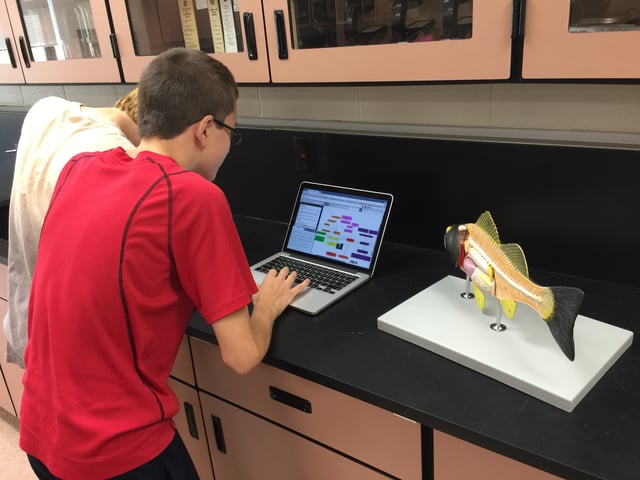We are pleased to announce the winners of the Ideaphora Connecting Knowledge Grants. After careful review, the judging panel has selected three well-deserving educators:
- $1,500 grant winner: Mike Jones, STEM instructor and technology coach, Bloomington School District 87, Bloomington, Illinois
- $500 grant winter: Kayley Bowie, middle school teacher, Crestomere School (Wolf Creek Public Schools,) Alberta
- $500 grant winner: Christi Collins, second grade teacher, Wise Primary School (Wise County Public Schools) Wise, Virginia
All of these educators have earned grant funding to be used toward professional development and an annual subscription to Ideaphora for themselves and their classrooms for the 2016-17 school year. Their stories and insights of applying concept mapping in the classroom will also be featured on this blog and in education publications throughout the year.
Concept Mapping in the Science Classroom
 Mr. Jones’ winning submission featured using Ideaphora in a unit of study on the Asian Carp infestation in American waterways. During Invasive Species Awareness Month, his students investigated the potential impact that Asian Carp could have on the Great Lakes and the 7 billion fishing industry if the species reach this area, as well as the possibility of it spreading to Canada.
Mr. Jones’ winning submission featured using Ideaphora in a unit of study on the Asian Carp infestation in American waterways. During Invasive Species Awareness Month, his students investigated the potential impact that Asian Carp could have on the Great Lakes and the 7 billion fishing industry if the species reach this area, as well as the possibility of it spreading to Canada.
Students first learned why the Asian Carp was a problem through numerous articles and videos. As each resource was introduced, students took notes in Ideaphora adding information to their map and listing questions they would like to investigate further. Students were then asked to find their own resources, which created an opportunity to teach them about the reliability and validity of their resources. Mr. Jones led several in-class activities, such as finding the population of fish in a pond, played the game, Invasion! and watched the BrainPOP movie on Online Sources. Each time, their learning was documented in their concept map. Students then researched possible ways to control the carp population and evaluate which would be the best option. Students were asked to identify a target audience with a call to action that implemented their, using their notes found in the concept map as evidence. The resources for the lessons can be found at www.7hScience.com.
As a result, students were able to think critically and gain a deeper understanding of a real-world issue that impacts them locally, and the world. Illinois suffers from several examples, such as the Ash Bore, Zebra Muscles, and Bull thistle. There is no easy way to solve these issues and the students learned about possible options, from barriers to toxins. This unit introduced students to a way to quantify options to a solution using a decision matrix (or Pugh chart). Simply stated, a Pugh chart is a way to assign values to different attributes of a solution. Students often choose solutions to problems more on feelings than data. Factors such as cost and time can easily be overlooked. This allowed them to take a more global look at the solutions.
Mr. Jones explained: “The use of Ideaphora made documenting their learning seamless. In the past, making a concept map would have just been a portion of the assignment. In this case, the use of concept mapping using Ideaphora was an integral part of the lesson. While this unit could have been rushed, the use of Ideaphora allowed my students the freedom to investigate and question based on their resources. This afforded the students the feeling of being in the driver’s seat, in control of their instruction. As a result, they took ownership of their learning, while I became the facilitator.”
Using Concept Mapping for Review and Study
In Ms. Bowie’s class, students created a knowledge map to review concepts introduced at the outset of a unit on plants. In-class lessons and discussions had focused on different uses of plants, as well as plant structures and adaptations. Students used resources the teacher had uploaded to Ideaphora to demonstrate the possible connections they could make between concepts.
Students not only more readily understood the concepts taught through mapping, they also learned how to navigate various online sources, including teacher-generated materials and other open education resources available on Ideaphora. Additionally, students gained an appreciation for using concept mapping as a useful study technique and to build deeper, more personal connections to the curriculum.
“Ideaphora helped my students solidify their understanding of important vocabulary,” Ms. Bowie explained. “Students were asking questions, learning new words, and clarifying prior knowledge. It's a great way for students to study and review key concepts.”
Concept Mapping with Young Learners
To reinforce lessons taught and give students more autonomy, Ms. Collins asked her second graders to conduct research on an animal of their choice. Students used Ideaphora to search for information among various resources and create a mind map of their findings.
Students learned detailed information about the animal they chose. In addition, students developed valuable researching skills and more experience using the digital tools they’ll need to become accustomed to as they advance in their education.
Ms. Collins stated: “In my classroom, Ideaphora become a platform for class brainstorming and visualizing thinking. I also learned how to present information in a more engaging way and gained ideas for additional ways to involve students in research and project-based learning.”
Go to our winners’ gallery to see their lessons and examples of student work.
Stay tuned for more examples and model lessons from these teacher leaders.
